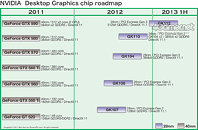
Did NVIDIA Originally Intend to Call GTX 680 as GTX 670 Ti?
Although it doesn't matter anymore, there are several bits of evidence supporting the theory that NVIDIA originally intended for its GK104-based performance graphics card to be named "GeForce GTX 670 Ti", before deciding to go with "GeForce GTX 680" towards the end. With the advent of 2012, we've had our industry sources refer to the part as "GTX 670 Ti". The very first picture of the GeForce GTX 680 disclosed to the public, early this month, revealed a slightly old qualification sample, which had one thing different from the card we have with us today: the model name "GTX 670 Ti" was etched onto the cooler shroud, our industry sources disclosed pictures of early samples having 6+8 pin power connectors.
Next up, while NVIDIA did re-christian GTX 670 Ti to GTX 680, it was rather sloppy at it. The first picture below shows the contents of the Boardshots (stylized) folder in NVIDIA's "special place" for the media. It contains all the assets NVIDIA allows the press, retailers, and other partners to use. Assets are distributed in various formats, the TIFF is a standard image-format used by print-media, for its high dot-pitch. Apart from a heavy payload, the TIFF image file allows tags, that can be read by Windows Explorer, these tags help people at the archives. The tags for images in TIFF format, of the GTX 680 distributed to its partners in the media and industry contain the tag "GTX 670 Ti".
Next up, while NVIDIA did re-christian GTX 670 Ti to GTX 680, it was rather sloppy at it. The first picture below shows the contents of the Boardshots (stylized) folder in NVIDIA's "special place" for the media. It contains all the assets NVIDIA allows the press, retailers, and other partners to use. Assets are distributed in various formats, the TIFF is a standard image-format used by print-media, for its high dot-pitch. Apart from a heavy payload, the TIFF image file allows tags, that can be read by Windows Explorer, these tags help people at the archives. The tags for images in TIFF format, of the GTX 680 distributed to its partners in the media and industry contain the tag "GTX 670 Ti".



